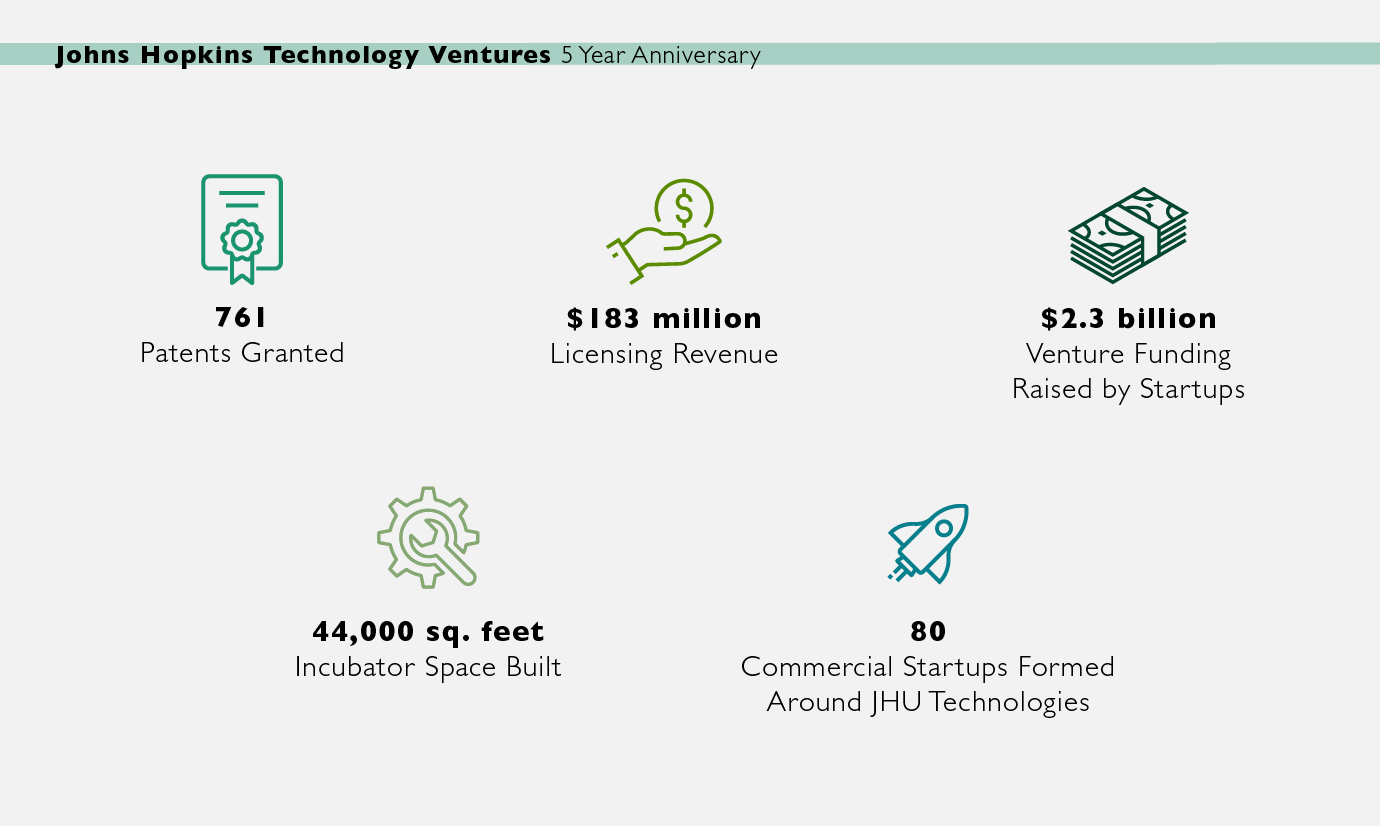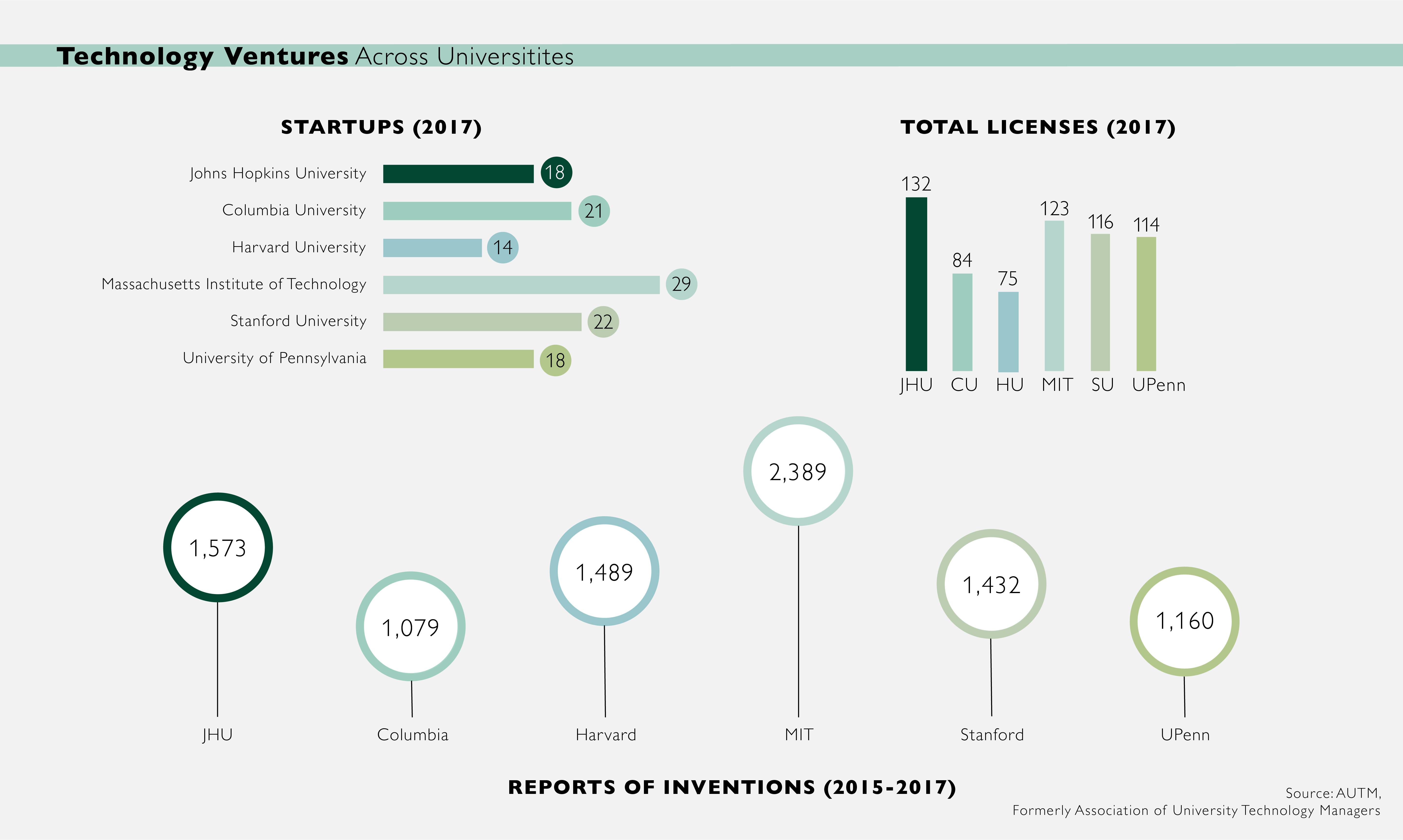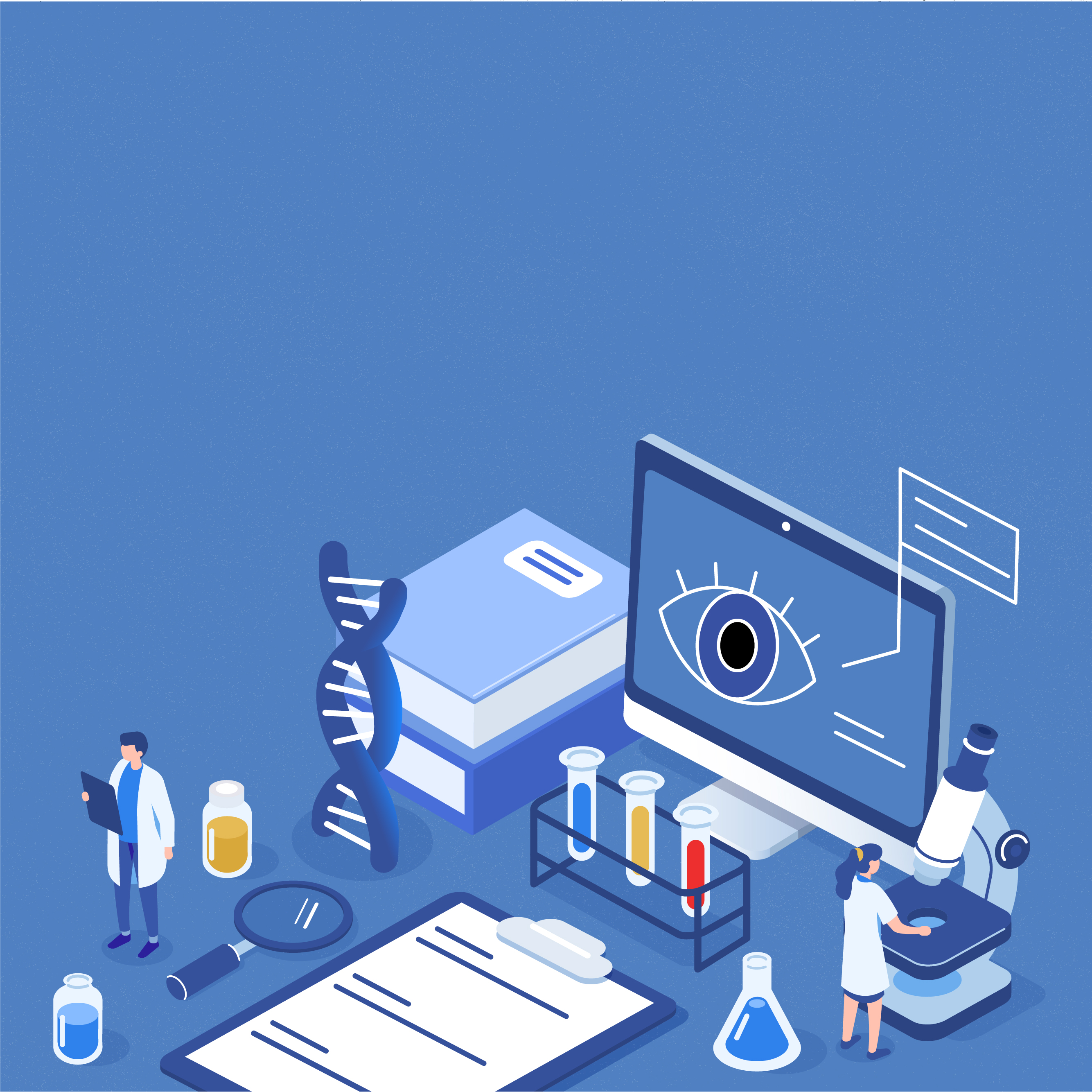Early cancer diagnostic tests, a synthetic soft tissue substitute, cranial implants and artificial lymph nodes are among the recent discoveries made by Johns Hopkins University School of Medicine faculty that promise to change medicine. Meanwhile, the licensing revenue generated from their commercial development — more than $150 million since 2014 — is helping to fuel reinvestment in the next generation of discovery at Johns Hopkins.
Scientific entrepreneurship is flourishing, thanks in large part to Johns Hopkins Technology Ventures (JHTV), a division of the university created in 2014 to support the translation of Johns Hopkins University research into commercial applications benefiting society.
“Our focus has always been on doing everything we can to help our patients,” says Paul B. Rothman, dean of the medical faculty and CEO of Johns Hopkins Medicine. “JHTV is a powerful way to further that goal, so that we can speed the process of getting our groundbreaking discoveries to those who need them most.”
Christy Wyskiel, JHTV’s founding executive director, says that while leading research universities all provide, to varying extents, the resources that JHTV offers, Johns Hopkins has combined all of them into one coordinated commercialization center, a “front door” for both industry and campus stakeholders looking to bring academic discovery to market.
JHTV is located on the first floor of 1812 Ashland, the heart of the Science + Technology Park at Johns Hopkins on the north side of the medical campus. There, more than 70 professionals help university inventors license technology, establish corporate collaborations and sponsored research projects, and launch startup businesses. JHTV’s FastForward innovation hubs are home to over 30 such companies, cementing Baltimore as one of the nation’s emerging innovation economies.
Results are impressive: In the past five years, school of medicine faculty have produced a yearly average of 310 reports of invention — the first step on the path to commercialization. They have also helped to found more than 100 of the university’s 159 self-sustaining startups, which have raised $2.3 billion in venture capital since 2014.
“I think [JHTV has] really helped make being an entrepreneur at Hopkins something that is celebrated,” says Justin Hanes, co-director of the Center for Nanomedicine at the Wilmer Eye Institute and founder of Kala Pharmaceuticals and Graybug Vision, each of which is developing therapeutics for eye diseases based on Johns Hopkins technology. “It’s not only acceptable, but there’s [now] an enthusiasm around people who want to start companies.”

Above: A look at some of the impact Johns Hopkins Technology Ventures has had on innovation at the university since its founding in 2014.
Creating a Welcoming Environment for Scientific Startups
The climate wasn’t always as encouraging. Prior to JHTV, inventors say the university was not inviting to entrepreneurs.
“If you were doing entrepreneurial work, it was considered nonacademic, something below what the academic pursuit was supposed to be,” says Drew Pardoll, director of the Bloomberg~Kimmel Institute for Cancer Immunotherapy. In 2014, he founded Potenza Therapeutics, a company developing novel antibodies for immuno-oncology therapies that was recently acquired by Astellas Pharma, Inc.
Jennifer Elisseeff, a professor at the Wilmer Eye Institute and Department of Biomedical Engineering, founded Aegeria Soft Tissue and Tissue Repair, startups that focus on soft tissue regeneration and wound healing, respectively. When she established them in 2009, she remembers contending with a lack of institutional resources as well as with other barriers.
In 2013, she and Pardoll agreed to co-chair a committee charged with looking into how to strengthen and improve the university’s innovation ecosystem. Their groundbreaking report, issued the following year, cited three areas where the university needed to make investments: space for entrepreneurs to work, translational funding for their projects, and resources such as mentorship and corporate partnerships.
Those recommendations led to the creation of Johns Hopkins Technology Ventures, an innovation center committed to strengthening and supporting entrepreneurship in the life sciences across the entire Johns Hopkins University community.

Above: How Johns Hopkins Technology Ventures compares to technology transfer offices at other universities.
“As people who are entrepreneurial choose where they want to work, they now see Hopkins as a place where they can do it,” Elisseeff says.
When Wyskiel became executive director of the new division, she also brought personal knowledge of the challenges facing academic startups. She followed biotechnology startups as an investor for two decades.
She considers leadership of JHTV a “once-in-a-lifetime opportunity.”
“I feel strongly that this agenda of service, and the work we are doing, ultimately will not only make the world a better place but has already brought vibrancy to Baltimore and will continue to make Baltimore a strong place for business to grow, entrepreneurs to thrive and students to remain after graduation,” she says.
Wyskiel credits the university’s investment in infrastructure and talented JHTV staff with meeting the needs of faculty and students as well as investors and the business community. She also praises Johns Hopkins faculty for aiming to bring life-changing products to market and “fighting for some of the best solutions of our time.”
“I’m so gratified that the faculty are focused on the big looming problems,” she says. “They’re not afraid to take the moonshot approach to research and technology development. We’re just here to facilitate their dreams and make them come true.”
Venu Raman, a professor in the Department of Radiology and Radiological Science, says he has relied completely on the resources and expertise at JHTV to help commercialize a drug that shows promise as a first-in-class cancer treatment. His 2016 startup, Natsar Pharmaceuticals, has created a compound that, in tests on mice, has been found to increase sensitivity to radiation and to treat some of the most resilient cancers — breast, lung and sarcomas.
Lacking formal business training, Raman raised $3 million in two years and worked with JHTV to secure three patents. He is aiming for a patient trial next year. The scientist hopes his work will inspire other Johns Hopkins inventors to become entrepreneurs.
“It’s hard work, but it can be done if you have the will and the data,” he says. “If you’re passionate enough, it can work out.”
Read more about innovations supported by Johns Hopkins Technology Ventures: Transparent Surgical Mask to Improve Communication with Patients and Electronic ‘Skin’ to Enable People with Amputations to Perceive Through Prosthetic Fingertips




